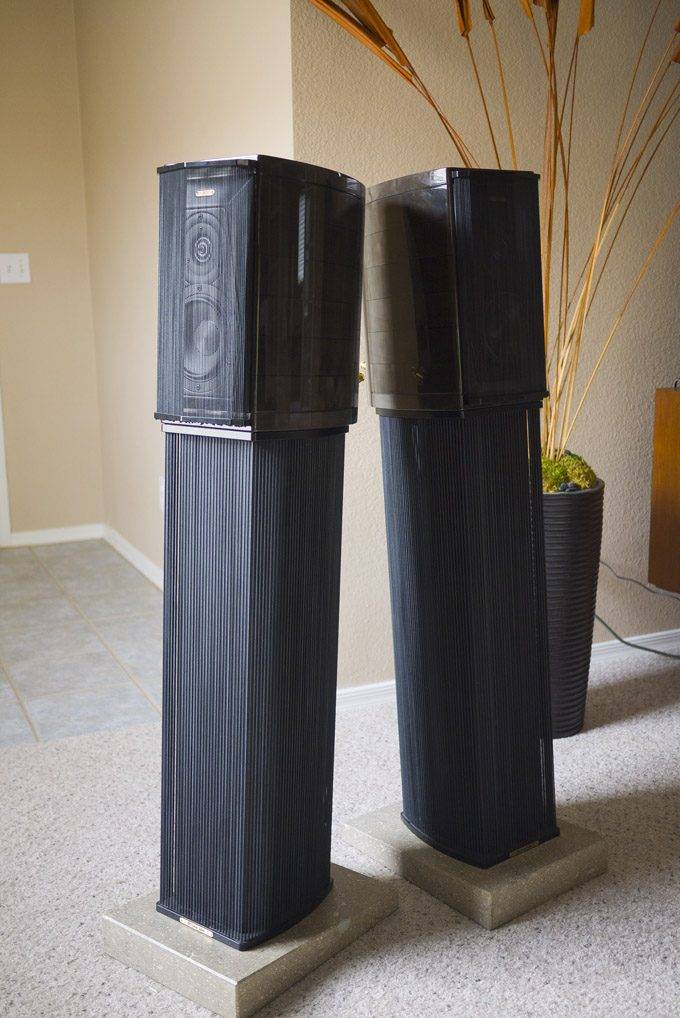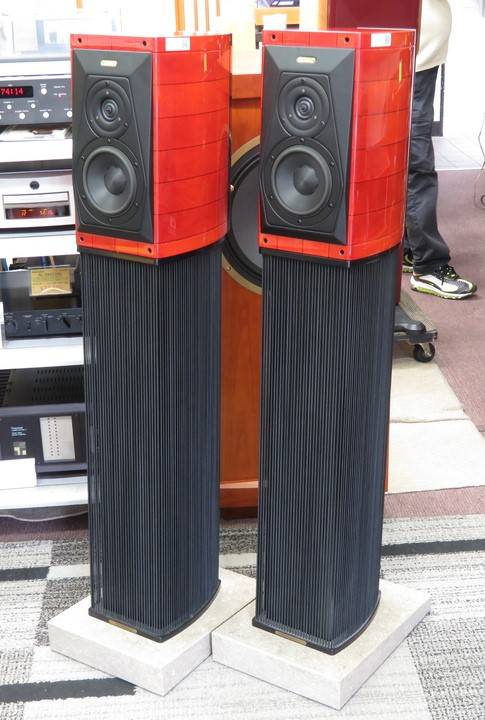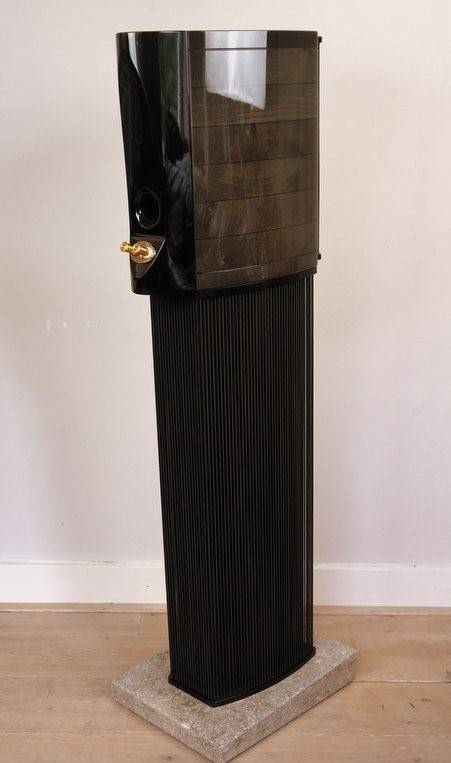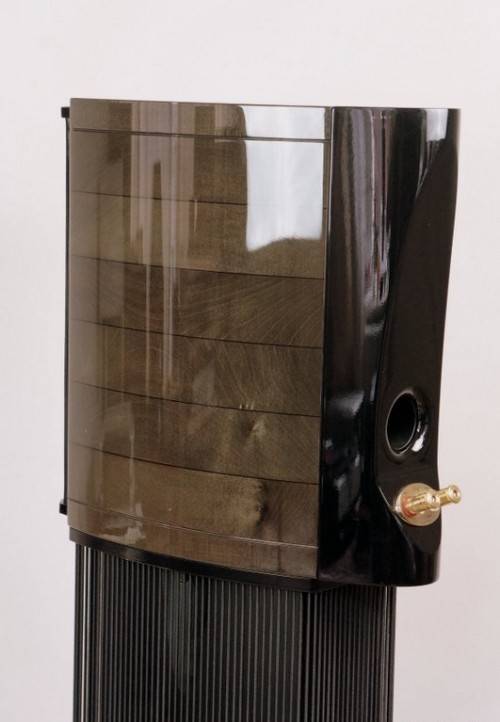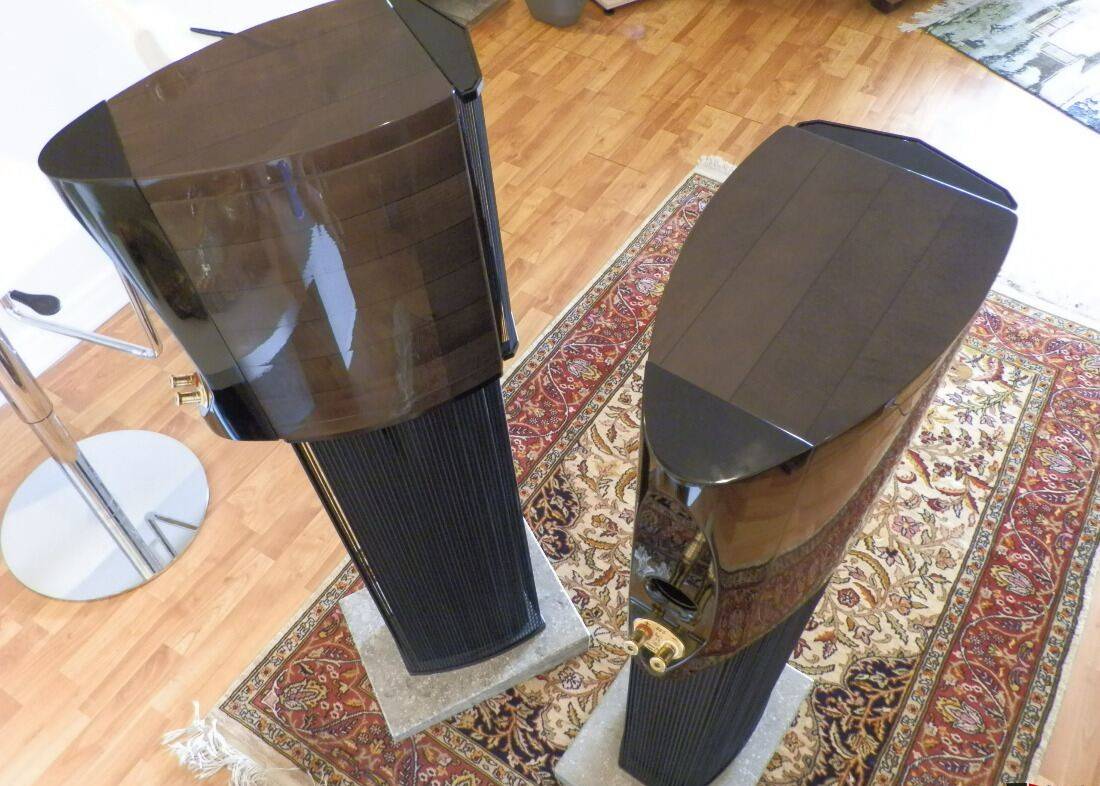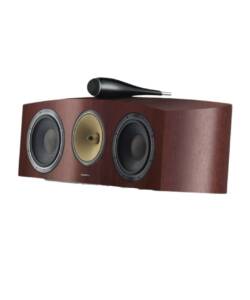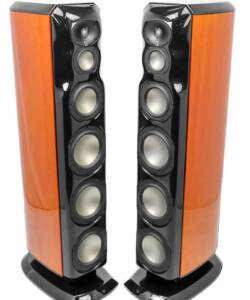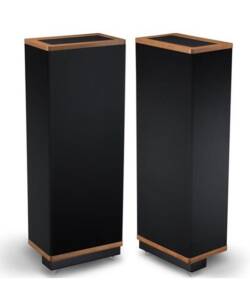Sonus Faber Guarneri Memento Bookshelf Speakers (Graphite Black)
Original price was: R190,000.00.R76,000.00Current price is: R76,000.00.
Audiophile eyes usually roll when a manufacturer describes a loudspeaker as a “genuine musical instrument.” Musical instruments have specific characteristics of pitch and timbre. Ideally, a loudspeaker should be a portal to the music; the speaker itself should be neutral in pitch and timbre—in other words, the opposite of a musical instrument. That the sound produced should be “musical” is a different argument.
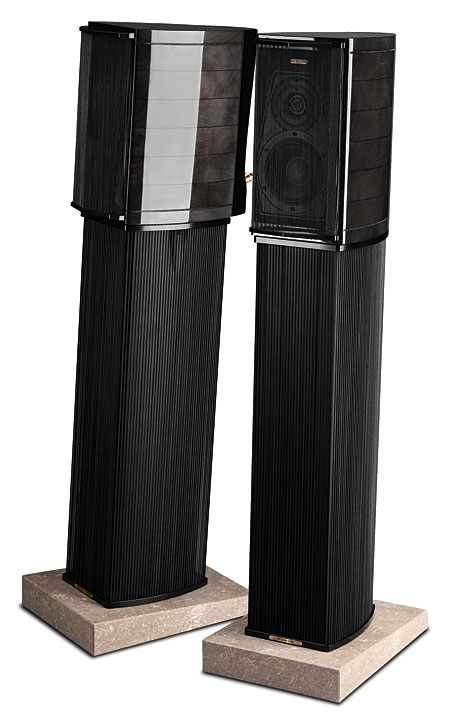
When, in 1994, Sonus Faber introduced the limited-edition Guarneri Homage loudspeaker (footnote 1) to celebrate the 250th anniversary of the death of master violin maker Giuseppe Guarneri (del Gesù), the company embraced the musical-instrument analogy in the process of designing the speaker. Even the design of the enclosure relied more on techniques used to build musical instruments in the 18th century than on science-based, 21st-century loudspeaker technology.
While other manufacturers have since imitated the Guarneri’s lute-like contours, which in 1994 were unique (Sonus Faber has apparently chosen not to enforce the patent it holds on the shape), none that I know of has attempted to duplicate its expensive, time-consuming, old-world process of construction.
The Guarneri’s cabinet consists of 21 staves of thick, solid, hand-selected maple, separated by thin wooden strips, dyed aniline black, that are aged for two years before being kiln-dried. The wood is then shaped, assembled by hand, and glued, using heat and pressure techniques similar to those used for centuries in the making of violins. The cabinet’s inner walls are lined as needed with copper sheeting (lead used to be in there as well, but use of the toxic heavy metal is no longer permitted), to distribute and damp resonances and produce cabinet-to-cabinet uniformity.
After being sealed with albumin, the speaker’s exterior is dyed with a natural reddish or graphite stain before being painstakingly varnished with a blend of natural organic substances, including Venetian larch turpentine, linseed oil, propolis, wine alcohol, gamboges, copal gum, and oliban. The finish is then sanded multiple times, like a fine violin, to a rich, deep gloss in yet another time-consuming process that only a few artisans are capable of performing. Again as with a fine stringed instrument, the finish is claimed to have a “profound” effect on the sound.
Add the curvaceous rear piece of aniline-dyed limewood, containing the port and speaker terminals; the sculpted, leather-clad baffle, itself a major construction job; and Sonus Faber’s once-unique, now oft-copied “string” grille—and you’d better believe that the Guarneri Homage created quite a stir in 1994, even before anyone had actually listened to it. The speaker is still one of the most beautiful looking, gracefully shaped, and solid loudspeaker cabinets ever constructed.
But there’s functionality behind all that beauty. The cabinet’s nonparallel walls are said to inhibit the generation of unwanted standing waves, and to help “guide” the backwave to the port. More important, the original Guarneri Homage, fitted with a custom-designed 6″ Scan-Speak woofer and custom Dynaudio Esotar tweeter, received rave reviews across the board for both its measured and its musical performance. But its high price ($9400/pair) and limited availability put it in the hands of only a lucky few around the world.
The Guarneri memento
Sonus Faber designer Franco Serblin followed the Guarneri Homage with the Amati Homage and then the spectacular Stradivari Homage, which he hoped would be—and many consider to be—his crowning loudspeaker achievement. Based on his experience designing the Stradivari, Serblin followed up with a much-improved (particularly in its bass performance) version of the Amati, the Amati anniversario (footnote 2). Now comes the “refreshed” Guarneri, which uses two new custom drivers: a 1″ Scan-Speak ring-radiator tweeter, crossed over at 2.5kHz to a 6″ Audio Technology polypropylene-cone woofer.
It’s important to remember that while a drive-unit’s faade may look familiar, what’s behind it is usually custom-tailored to the end-user’s needs. Like the resemblances between an airport rental version of a well-known automobile and the top-of-the-line edition, the similarities can be little more than superficial.
On the other hand, while the Guarneri memento’s cabinet looks spectacular, it’s still a 6″ woofer and a familiar Scan-Speak ring-radiator tweeter in a box. A pair of these small speakers will set you back $15,000. The price includes the shapely Column stands to which the speakers are bolted, with stone wedge bases from a quarry near the Sonus Faber factory in Arcugnano, Italy.
Setup
Patrick Butler of Sumiko Audio, Sonus Faber’s US distributor, paid me a visit to set up the Guarneris on their Column stands using the company’s tried-and-true series of recordings, which includes Jennifer Warnes’ “Ballad of the Runaway Horse,” from Rob Wassermans’ Duets CD. Squeezing every drop of performance—especially in terms of bass—from a small design such as the Guarneri memento requires skill, experience, and patience, something Sumiko insists that all its dealers possess before they can be awarded a Sonus Faber franchise. I left the room. When I returned, the Guarneris were sitting close to where virtually every other speaker has sounded best in my room.
The speaker’s high-frequency performance was beyond reproach as long as I sat below the level of the tweeter and used the provided Columns, which angle the front baffles back. When I stood up, there was an obvious HF suckout.
A special loudspeaker, or an overpriced “lifestyle” looker?
Any successful loudspeaker design is a careful blend of science and art. Measurements taken under anechoic and quasi-anechoic conditions don’t necessarily translate well into actual listening rooms. Nonetheless, such measurements are important—a lumpy response curve measured under controlled conditions is rarely flattened out by a typical living room.

What if you would meet the queen or princess of your dream while looking something completely different. What if she just stood there and waited for you. An accident waiting to happen. What would you do?
Ubiq – Vklop chief Igor Kante was lending me Denmark Gryphon audio integrated amplifier Diabolo for test and while taking it to my car i spot something that lightened my led diodes (as Bender might put it). Sonus Faber Guarneri Memento loudspeakers. In a moment i got quick flashback of all the raves i heard about it. I went home but contemplation was too intensive so i rang Igor and arrange to demo Memento’s as well.
Sonus Faber Guaraneri Memento is a representer of Homage series. They should be labeled as monitor speakers, but with original stands, they look like a sculpture from a hands of a master designer. This is practically only speaker in Sonus Faber line which enclosure is completely wooden (no MDF). It’s made out of 21 staves of hand selected maple blocks that are naturally dried for at least two years.
Cabinet is shaped like traditional lute instrument. All the gluing is done by traditional Italian recipes derived from mouth to mouth heritage. These are the secrets of greatest violin craftsmanship. Finish alone is done in 10 segments. Each layer is hand painted and sanded. Result is stunning gloss “Graphite” finish and finest i’d seen up to date.
Unpacking them was screaming; style, prestige, quality! Mementos are stored in the wooden box and covered with special textile bag. Setting them up took quite some time. Whole speaker system is consisting from three separate modules. The wooden enclosure, massive body covered with nylon strings that resemble original lute strings and “stone” stand. Once assembled the appearance is timeless.
It’s funny that i needed 2 days to get used to the Mementos. I’m use to completely different experience when you welcome new speakers into your system, but Mementos gave me quite a shocking treatment. At first they seemed to be to closed and dark, but so often airiness and resolution is mistaken with real character and tone of instruments.
After transitional period I started to fall for of these beauties. How often we read enchanted reviews of owners and reviewer to be left unimpressed when we test them.
I listened to a lot of speakers, but only few really left me in that special state of mind; a continuous loop of longing. The Memento is the real “reminder”.
Guarneri Memento proved to be real instrument. I would say it is one of the most musical speaker i heard. Music is simply plaid and let you forget about all audiophile nags we incorporate in our listening. Some said that they lack the bass but i wouldn’t dare to say so. I guess they didn’t use a proper amplification with them. There is plenty of well controlled and i would say natural bass. If you want over hyped bass you can always add a subwoofer or look for another kind of speaker.
There is one catch. You have to drive them with quite few watts of power. You might be left with only half experience without proper amplification. Sonus Faber is testing them with their Musica amplifiers and I’m wonder if they really know Mementos real potenital :).
Lack of bass that some folks complained about might be in absence of a proper amplifier. Be careful before drawing conclusions.
It is such an avid moment to hear bass and instruments plaid well and controlled without too much room tweaking and treatment from the very start. That is something that set apart hi-fi and high end equipment. And this is also apparent with good recordings. Steve Hoffman mentioned in our is answering in our interview that’s almost all secrets of good sound are hidden in good recording and mastering. And it’s the same with reproduction. With first class enclosure and the knowledge behind the speaker building you are saved from many anomalies that can be attached to poorly designed and constructed speaker. The “boominess” is practicaly absent in well designed speaker and Sonus Faber Memento is remarkable in this regards.
Instruments can simply disappear and there is that natural, life like feeling that surround the music. I could go on and on, but please experiance it for yourself.
My favorite jazz artist John Coltrane never sounded better and closer to my inner jazz child :). If you have the chance grab Alice Coltrane Translinear light, and simply float in the stratosphere of spiritual jazz. I’m still amazed how good this album sounds. There is something that makes you feel closer to God.
Is Sonus Faber Memento most neutral and precise speaker on the planet? No! But is for sure one of the most musical and natural sounding speaker. And best looking! Period!
Some see Sonus Faber Guarneri Memento as a fashion or style statement. Through my eyes such a is product shows love for music and and traditional craftsmanship.
If acoustic, vocal, small ensemble, natural recorded music is your thing than look no further. An audition is a must!
There is an ultimate proof for reviewer to stand behind paper tiger stuff.
I’m buying those cutes. Yes they are that good and above!
| Italian Grace – Sonus Faber’s Guarneri Memento |
| When it comes to culture, style and tradition, it’s hard to beat the Italians.
The loudspeakers under review here are ideal examples; I can’t think of another loudspeaker manufacturer that has taken the time and effort to finish a product to the level of craftsmanship and refinement seen here. The Guarneri Memento is named in tribute to the art of the Cremonese violin makers of old, as are the other family members of the Sonus faber Homage Series of loudspeakers — the Amati Annicersario and the Stradivari Homage. Sonus faber, loosely translated from Latin as “handcrafted sound,” was established in 1983 by a gentleman named Franco Serblin. The company’s philosophy has always been based on a three-fold foundation: driver development, crossover theory and cabinet design. Serblin continues to work as the company’s chief creative designer and this is likely the reason why the industry regards Sf products as high-end, both in system design and style. Assembly & Appearance |
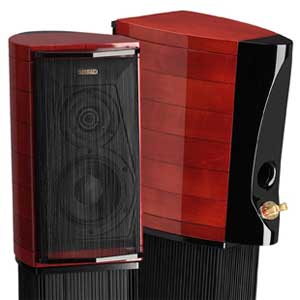 |
The enclosure finish is not only a work of art, as Sf states that it also has a “profound effect” on the final sound — a claim with which I agree as I researched this issue years ago.The gorgeous finish is accomplished by first sealing the cabinets with albumin to prevent the many layers of varnish from penetrating the wood. At least 10 coats of varnish are applied and hand sanded before the final polishing takes place. Sf employs a unique blend of organic substances including Venetian larch turpentine, linseed oil, propolis, wine alcohol, gamboges, copal gum and oliban in the finishing process. All work is done manually and the result is a mirror-like finish similar to that found on a violin. The Guarneri Mementos are available in both a piano gloss “Red Violin” or gloss “Graphite” finish. The grilles covering the baffles are unique as they are comprised of a series of silk strings. Strings (made of elastomer wrapped in silk) continue along the speaker stands, lending a well-finished, pleasing flow to the overall motif.
Each enclosure is constructed of 36 individual sections of selected solid maple in a constrained-mode damping arrangement designed to cancel undesirable resonance. The interior (side) walls are damped in specific areas with sheet copper, while small pieces of lead are used to further tune each cabinet and prevent resonances. The cabinet’s visible sections are seamed with ebonized maple. The maple used for the enclosures is naturally dried for two years and then stabilized in kilns.
Each cabinet is hand-assembled using organic glue and heat-compression procedures identical to those used centuries ago in the manufacture of violins.
The Sound
As the SFs have an efficiency rating of 88dB, I concluded that some amplifiers will not drive them to their full potential. This prompted me to connect them first to Simaudio’s reference system, the A-8 power amp, the P-8 preamp and the Andromeda CD player (all reviewed in the last issue). This system combination resulted in very accurate sound, but not what I’d call perfect, due to the lack of some upper bass and high frequency harmonics. Some members of the listening panel disagreed with my deduction-but I stand firm and you’ll understand why as you read on.
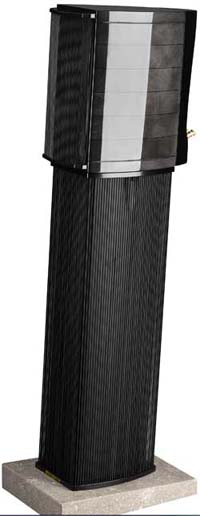 |
Enter, the Bryston 28B SST monoblocks (reviewed in the last issue). Not only did this 1000 watts/channel solid state design drive the Fs with ease, the sound took on weight, body, texture, dynamics, detail and all the other good things reviewers (including this one) look for in a synergistic system set-up. Note that the Brystons are rated at 1000 watts with an 8-ohm load or 2000 watts into a 4 ohm load, which is the Guarneri Memento’s impedance rating.
To test the Sf’s ability to cope with a variety of music, I used classical, jazz, blues and rock’n roll albums. Cope it did, although more successfully with some music than with others. Classical music, including baroque ensembles and string quartets, for example, was handled very well, clearly revealing the timbre, or personality, of the instruments. Large orchestral works — music from Wagner, Beethoven, Rimsky-Korsakov and Tchaikovsky — really brought the Guarneri Mementos to life and they managed dynamic passages without constraint. Most impressive, although not entirely evident with all amplifiers I tried, was the Bryston/Sonus bass. It was rich, full-bodied and, though resolution suffered somewhat below about 42Hz, it was very gratifying. Thinking that my in-house single-ended Wyetech Labs Topaz amplifier (reviewed in Vol.13, No.2) might do a reasonable job, I connected it to the loudspeakers. BAM! I was right and, with this combination, most of the missing harmonics were recovered. The 18 watts/channel single-ended Topaz provided enough power to drive the loudspeakers to about 110dB without flinching — that’s enough volume to disturb the neighbors and make your ears ring. The Topaz did what it does best: harmonics, detail, smoothness and beautifully executed tonal finesse. However, I wasn’t entirely happy with the sound, thinking that there must be still another amplifier that could heighten the all-round performance even more. And there was. The Guarneri Mementos perform remarkably well when driven hard, with volume levels up to 115dB. That’s enough to recreate sound pressure levels comparable to a live rock concert or a large orchestral arrangement with kettle drums, cannon shots and the kitchen sink. At lower volumes, the Guarneri Mementos sound well tempered and relaxed; easy on the ears. The overall voice of the loudspeakers is soft and subdued, never in your face even with driving dynamic musical program material; yet, musical spirit is maintained. One note about the grilles: as they consist of small silk strings, they can, and will, resonate ever-so-slightly at high volumes and I recommend removing them on those occasions. However, the resonances are inaudible at low volume levels. |
Synopsis & Commentary:
Although it may take patience, the most important issue is to find the type of amplification that suits the loudspeaker and personal taste. As you can see, I have tried to “extract” the best sound from the Sonus fabers by seeking a synergistic coupling with other components. If you follow my system recommendation, you will get what I consider the best sound. I realize that my opinion may be construed as subjective, and others may not agree. However, I think I have a good understanding of high-end audio and, as I regard synergy as a primary concern for achieving the best possible performance, I selected well-matched components and took great care in the system set-up.
I trust that the North American distributor is cognizant of the importance of choosing dealers who are qualified to accomplish the task of matching components. However, even the “qualified” sometimes fail to offer the best system solutions as they can only use components they sell. I sell no components and I have a number of amplifiers, cables and source components in-house with which to experiment. Based on this, a very time consuming process, I envision a logical and, hopefully, a synergistic amplifier match.
I believe that most single-ended vacuum tube amps will not drive the Sfs, but if you have one already, I recommend you take it to the dealer and test how it handles 88dB sensitivity — some will (like the Wyetech Labs Topaz), many won’t. Any powerful solid state amp (around 100 watts/channel) will do the job. However, more powerful ones, such as the Bryston 28B SST, will result in significantly better control of bass frequencies, clearer midrange and greater body to the music. The Bryston monoblock amps provide a stunning image when coupled with the Sonus fabers, and they will never run out of steam. If tube gear is your passion, you will have to find a high-current amp with beefy power supplies that delivers loads of voltage to the speaker terminals.
In my final reflections I’d like to connect the Guarneri Memento’s sound quality to their appearance. These speakers simply cannot be ignored either by listeners or by interior decorators. They sound great, they look great and they will affirm their proud owner’s concern for music and style.
Footnote
Guarneri — for whom the model under review is named — was a pupil of Nicolo Amati, the famous violin maker (1596-1684). The founder of the Cremona school was Andrea Amati who lived from 1520 to 1578 and whose earliest violins date from c.1564. His labels bore the name Amadus and he is credited with the basic design of the modern violin. His sons were Antonio Amati and Girolamo or Geronimo Amati, who worked together and closely followed their father’s patterns in making violins of graceful shape and sweet tone with a characteristic amber-coloured varnish finish. Nicolo Amati, son of Girolamo, brought the Amati violin to its height after 1645. Among Nicolo’s other pupils was another great violin maker,
